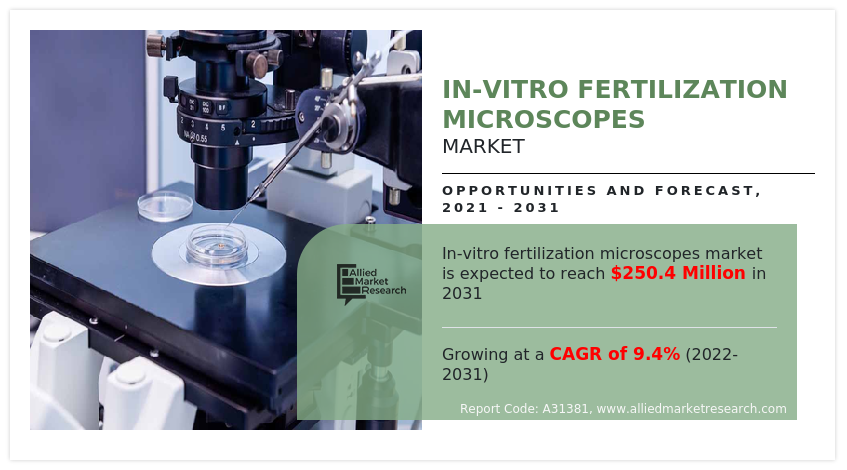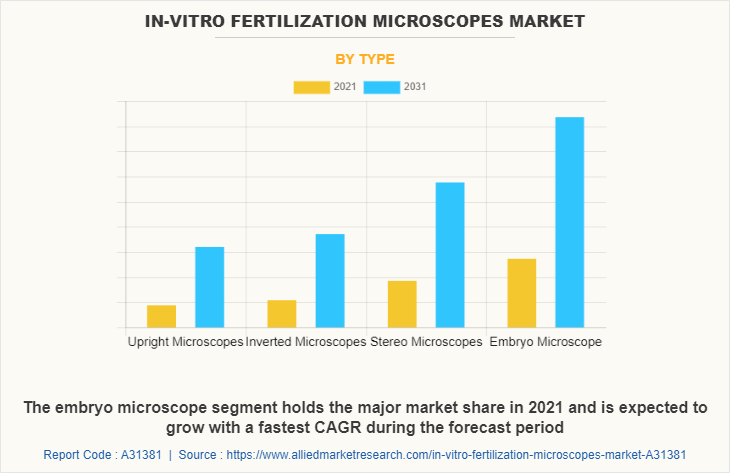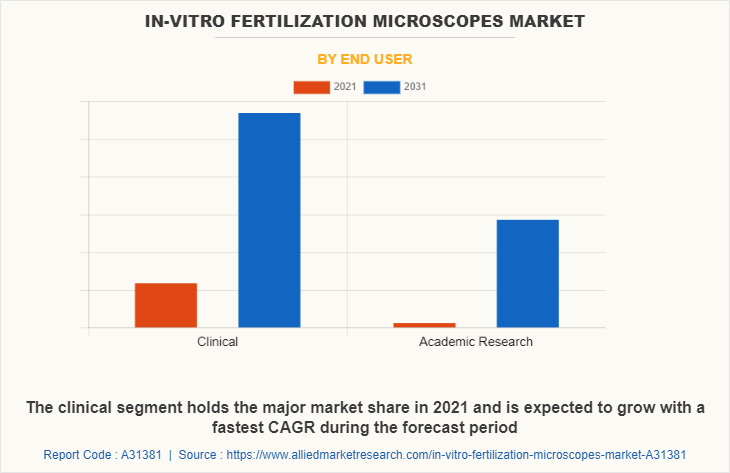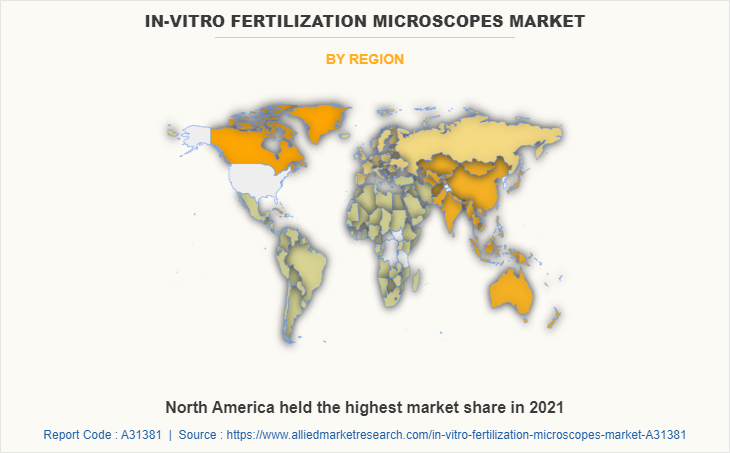In-vitro Fertilization Microscopes Market Research, 2031
The global in-vitro fertilization microscopes market was valued at $105.4 million in 2021, and is projected to reach $250.4 million by 2031, growing at a CAGR of 9.4% from 2022 to 2031. In-vitro fertilization microscopes are used for various procedures, such as semen analysis, oocyte preparation, in-vitro fertilization, and the overall analysis of the embryo. The increasing success rate of in-vitro fertilization procedures, as well as the availability of financial aid, are expected to drive In-vitro fertilization microscopes market growth.

Furthermore, innovations in microscopes are increasing treatment efficiency and are expected to lower procedure costs. Some of the significant market advancements include improved microscopic examination quality through high contrast and innovations in IVF microscope-related equipment. Hamilton Thorne Ltd., for example, launched the Dynamic Targeting System (DTS) for the LYKOS laser system in May 2019, which is compatible with the company's inverted microscopes used for IVF applications.
High cost of the microscopes is the main challenge that is expected to hinder the market growth during the forecast period. Apart from ICSI or IMSI machines, other important equipment are centrifuge, CO2/ Trigas/ Dry incubators, Oocyte/ Ovum aspiration pumps, Laser Hatching System, cryo cans, and embryoscope. This microscopes used in IVF procedures is quite high as compared to others equipment, which is expected to hinder the in-vitro microscope market growth.
The industry players are investing a lot of effort on the R&D of smart and unique strategies to sustain their growth in the market. These strategies include product launches, mergers & acquisitions, collaborations, partnerships, and refurbishing of existing technology. For instance, Zeiss and Hamilton Throne joined the Global Fertility Alliance in June 2020. The Global Fertility Alliance is committed to assisting in the standardization of ART (Assisted Reproductive Treatment) laboratory processes. The alliance's current members are Merck KGaA, Illumina Inc., and Genea Limited. Furthermore, the CRM's(assisted reproductive technologies) advanced latest IVF techniques include the EmbryoScope time-lapse system, frozen embryo transfer, microsurgical (testicular) sperm extraction, endometrial co-culture, and assisted embryo hatching. Taking advantage of the most recent advances in reproductive medicine, including a variety of advanced IVF techniques and services offered in conjunction with IVF, boosts the IVF microscopes market is expected to boost In-vitro fertilization microscopes market opportunity during the forecast period.
The key players profiled in this report include Linkam Scientific Instruments, Olympus Corporation, Leica Microsystems, Meiji Techno, Zeiss, Euromex Microscopen B.V., Labomed Europe B.V., Nikon Corporation, Narishige Group, Eppendorf AG, and Hamilton Thorne Ltd.
The in-vitro fertilization microscope market is segmented on the basis of type, end user, and region. By type, the market is divided into upright microscopes, inverted microscopes, stereo microscopes, and embryo microscope. By end user, the market is classified into clinical and academic research. By region, the market is analyzed across North America, Europe, Asia-Pacific, and LAMEA.
The in-vitro fertilization microscopes market is segmented into Type and End User.

By type, the embryo microscope segment dominated the market in 2021. The embryo microscope, now in use at IVF lab, is a new tool designed specifically for use in IVF laboratories. It has a camera and computer system designed to capture images of embryos growing in an incubator during in vitro fertilization cycles. These images, which were captured by a camera as the embryos developed in their culture dish, are displayed on a computer screen in the IVF lab. The computer system not only displays images of embryos; however, it displays information about their growth pattern. This information enables embryologists at Ovation Fertility Austin to observe healthy embryo development and detect any problems with cell division timing that may occur during the early stages of growth. These are anticipated to be the major factors affecting the In-vitro fertilization microscopes market size during the forecast period.

By end user, the clinical segment dominated the global In-vitro fertilization microscopes market share in 2021. Major factors driving segment growth include rise in awareness of IVF treatment and increased private investor investments in infertility clinics. The increasing use of a variety of microscopes in clinical Assisted Reproductive Technology (ART) procedures is expected to drive segment growth during the forecast period. Microscopes are used in clinical ART facilities to select gametes and perform clinical procedures. Oocyte & embryo morphology and viability are examined using stereo microscopes, whereas sperm morphology, motility, and viability are examined using upright microscopes. While both types of microscopes are used in clinical settings, inverted microscopes are best suited for ART.

By region, Europe dominated the global market in 2021 and is projected to remain the fastest-growing segment during the In-vitro fertilization microscopes market forecast period. Time-lapse technology with clinic-designed algorithms has seen widespread adoption in the region. Innovation in microscopes that provide all imaging requirements in a single embryo chamber, reducing the need for multiple workstations, assists in the saving of space and cost of the procedure. Furthermore, due to the falling birth rate of around 2.21 children/woman in Germany, the subsidy of IVF treatment is an important factor in the growth of this market. In addition, the national health plan (PSN) covers roughly half of the total cost of treatment. It allows for three cycles of in-vitro fertilization, which is expected to boost the market for in vitro fertilization, particularly in Germany. This factor boosts the IVF microscopes industry market growth in Europe.
Impact of COVID-19 on the In-Vitro Fertilization Microscope Industry
- COVID-19 has negatively impacted various industries such as microscope that has led to a drastic decline in microscope sales. In-vitro fertilization microscope, which is widely used in IVF treatment, witnessed reduction in the In-vitro fertilization microscope demand globally.
- During the World Health Organization's (WHO) COVID-19 pandemic, which was declared in March 2020, fertility societies worldwide recommended that IVF treatment be discontinued, except for essential medical fertility preservation. IVF centre operations resumed after measures such as decontaminating & validating equipment, ensuring adequate staffing, and completing risk assessments.
- The COVID-19 pandemic had a negative impact on the market due to social distancing norms and delays in fertilisation operations. As IVF patients must visit the clinic once a week, IVF procedures were halted during the pandemic.
Key Benefits For Stakeholders
- This report provides a quantitative analysis of the market segments, current trends, estimations, and dynamics of the in-vitro fertilization microscopes market analysis from 2021 to 2031 to identify the prevailing in-vitro fertilization microscopes market opportunities.
- The market research is offered along with information related to key drivers, restraints, and opportunities.
- Porter's five forces analysis highlights the potency of buyers and suppliers to enable stakeholders make profit-oriented business decisions and strengthen their supplier-buyer network.
- In-depth analysis of the in-vitro fertilization microscopes market segmentation assists to determine the prevailing market opportunities.
- Major countries in each region are mapped according to their revenue contribution to the global market.
- Market player positioning facilitates benchmarking and provides a clear understanding of the present position of the market players.
- The report includes the analysis of the regional as well as global in-vitro fertilization microscopes market trends, key players, market segments, application areas, and market growth strategies.
In-vitro Fertilization Microscopes Market Report Highlights
| Aspects | Details |
| Market Size By 2031 | USD 250.4 million |
| Growth Rate | CAGR of 9.4% |
| Forecast period | 2021 - 2031 |
| Report Pages | 28 |
| By Type |
|
| By End User |
|
| By Region |
|
| Key Market Players | Nikon Corporation, hamilton thorne, inc., Leica Microsystems, Meiji Techno., NARISHIGE Group., LINKAM SCIENTIFIC INSTRUMENTS, Olympus Corporation, Labomed Europe B.V., ZEISS International, Euromex Microscopen B.V. |
Analyst Review
In-vitro fertilization microscopes are used for a variety of procedures, including sperm analysis, oocyte preparation, in-vitro fertilization, and embryo analysis. The surge in success rate of in-vitro fertilization procedures as well as the availability of financial aid are expected to drive market growth. Inverted microscopes are manufactured by very few companies as they are expensive to manufacture. So, there is a shortage of these microscopes than the other forms of microscopes, which is expected to hamper the market growth during the forecast period. Furthermore, manufacturer product innovations are increasing treatment efficiency and are expected to reduce procedure costs. Some of the significant market advancements include improved microscopic examination quality through high contrast and innovations in IVF microscope-related equipment. This factor is anticipated to boost the IVF microscope market demand during the forecast period.
Among the analyzed regions, Europe is expected to account for the highest revenue in the market by the end of 2031, followed by Asia-Pacific, North America, and LAMEA due to factors such as growing fertility tourism, legal reforms, and product innovation. Time-lapse technology with clinic-designed algorithms has seen widespread adoption in the region. Such factors are responsible for the leading position of Europe and North America in the global In-vitro fertilization microscope market.
The major growth strategies adopted by In-vitro fertilization microscope market players are investment and agreement.
The factors driving the market are expansion in application scope and high demand for technologically advanced magnification devices. Soaring demand from the healthcare sector, as well as the rapidly growing semiconductor industry, are key factors driving market In-vitro fertilization microscope growth.
Europe is expected to provide more business opportunities for the global In-vitro fertilization microscope market in future.
By end user, clinical segment acquired the maximum share of the global in-vitro fertilization microscope market in 2021.
Linkam Scientific Instruments, Olympus Corporation, Leica Microsystems, Meiji Techno, Zeiss, Euromex Microscopen B.V., Labomed Europe B.V., Nikon Corporation, Narishige Group, Eppendorf AG, and Hamilton Thorne Ltd.
Clinical and academic research are the major customers in the global In-vitro fertilization microscope market.
The report provides an extensive qualitative and quantitative analysis of the current trends and future estimations of the global In-vitro fertilization microscope market from 2021 to 2031 to determine the prevailing opportunities.
Loading Table Of Content...



